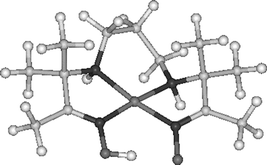The thermodynamic equilibria of copper(II), zinc(II), calcium(II) and gadolinium(III) with 3,3,9,9-tetramethyl-4,8-diazaundecane-2,10-dione dioxime (L1) have been studied at 25 °C and an ionic strength of 0.15 mol dm−3. Copper and gadolinium form stable complexes with the ligand while the corresponding zinc species are more than 9 log units less stable. No complexes between calcium and the ligand were detected. The low binding strength of L1 towards zinc is attributed to the square-planar coordination geometry forced on the metal ion by the ligand as revealed by molecular mechanics calculations and molecular dynamics simulations. Speciation calculations, using a computer model of blood plasma, indicate that, despite the high concentration of zinc(II) and calcium(II)
in vivo, L1 is able to increase the low-molecular-mass fraction of copper in plasma. Octanol/water partition coefficient of [CuL1H−1] indicates that although this species is largely hydrophilic, approximately 6% of the complex goes into the octanol phase and hence may promote dermal absorption of copper by the same amount. The dermal penetration rate is calculated to be 4.0 × 10−4 mm h−1. The [CuL1H−1] complex, which predominates at pH 7.4, is a poor mimic of native copper–zinc superoxide dismutase. Biodistribution experiments using the 64Cu-labelled [CuL1H−1] complex indicate an initial high uptake of this species in the liver followed by redistribution into muscle. Only a small amount is excreted through the urine.

You have access to this article
 Please wait while we load your content...
Something went wrong. Try again?
Please wait while we load your content...
Something went wrong. Try again?


 Please wait while we load your content...
Please wait while we load your content...